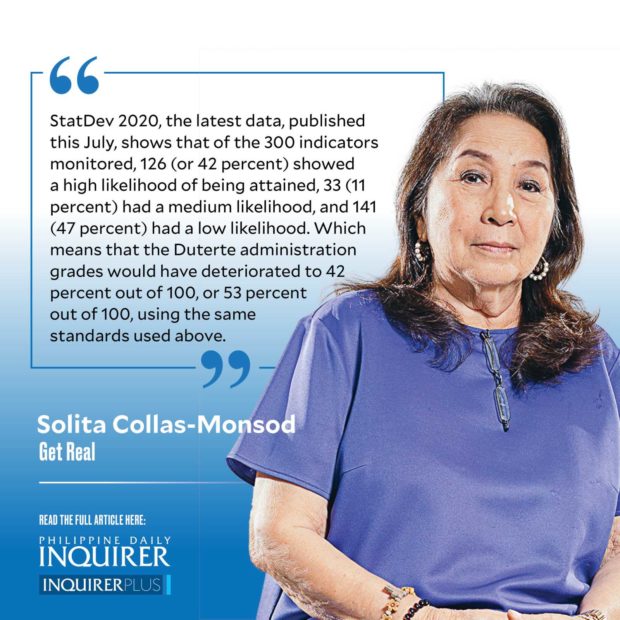Failing grade for admin — per its own StatDev
The Duterte administration is on its last legs—well, on the last seven months of its 72-month term. When it started out, one of its first acts was to formulate a Philippine Development Plan (PDP) 2017-22, which was guided by President Duterte’s 0-10-Point Socioeconomic Agenda.
The PDP has a lot of targets/indicators—more than 500 of them, of which only slightly over 300 were monitored, for various reasons. And these are monitored by the Philippine Statistics Authority (PSA) and published annually, based on data it gathers from the concerned agencies themselves. The PSA works mightily on gathering these data, which it publishes in July of each year, just in time for possible inputting to the President’s State of the Nation Address (Sona). It is called StatDev—Statistical Indicators on Philippine Development.
One would think that this periodic monitoring would be useful to the President—evidence-based data showing whether agencies were meeting these self-imposed annual targets—so the President could commend his subordinates or warn them to shape up or be fired. The only agencies he could not scrutinize this way would be the PNP and the PDEA, because the chapters on security, safety, peace and order in the PDP (two of them) do not have any targets/indicators of success. Why not? Because of national security reasons. I kid you not. This is one of the weaknesses of the PDP.
Unfortunately, not once in all the six Sonas the President has given since his inaugural in 2016 has he ever mentioned either the PDP, or that the targets of his administration are being monitored yearly by the PSA. It is as if the Plan did not exist, or the efforts of the PSA at monitoring the targets are inconsequential. I hope the next President realizes how invaluable a tool the PDP and the StatDev would be for her administration.
Well, how has the Duterte administration measured up to its own targets, as monitored by the PSA? Two years ago, at about the middle of this administration, I looked at StatDev 2018 and noted (in this column) that its 307 indicators included 138 (44.95 percent) which had a high likelihood of being attained by the end-of-plan, 42 (13.68 percent) which had a medium likelihood, and 127 (41.37 percent) low-likelihood indicators.
If we assumed that the StatDev were an exam of the Duterte performance, and that those targets with a high likelihood of being attained were “correct” answers, Mr. Duterte would get a grade of 44.95 out of 100. Clearly a failing grade. If we include the medium likelihood indicators together with the high likelihood indicators, the grade would increase to 58.63 out of a possible 100. Still failing, by almost any metric.
That was two years ago. What about now? StatDev 2020, the latest data, published this July, shows that of the 300 indicators monitored, 126 (or 42 percent) showed a high likelihood of being attained, 33 (11 percent) had a medium likelihood, and 141 (47 percent) had a low likelihood. Which means that the Duterte administration grades would have deteriorated to 42 percent out of 100, or 53 percent out of 100, using the same standards used above.
Understand, Reader, that’s not my evaluation. That is the StatDev’s evaluation. And that’s the overall grade. What sectors performed relatively better or worse? The best-performing sector was the competitiveness sector (the Department of Trade and Industry, the Philippine Competition Commission), which turned in the best performance with 79 percent of all targets with high likelihood of being attained. However, it has big failures too—in the targets of achieving an improvement in the Global Competitivenes Index (consumer welfare and market efficiency) and in reducing the barriers to entry.
Which was the worst-performing sector, according to the StatDev? It was the shelter and housing sector, which apparently had no target that had a high likelihood, or even medium likelihood, of being achieved. The sector showed red over 100 percent of its targets. This is puzzling, because I heard the Department of Human Settlements and Urban Development (DHSUD) reporting to President Duterte (in one of the Report of the President TV shows) that it had overachieved its targets. But I will leave it to the two government agencies, the PSA and the DHSUD, to settle the discrepancy among themselves. (I know the PSA gets the data from the agencies, but they have to make sure there is no fudging).
That’s the Duterte administration performance, folks, as determined by PSA’s StatDev.
——————
solita_monsod@yahoo.com





















